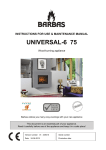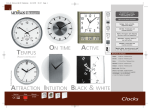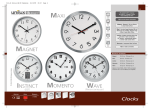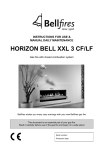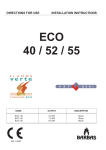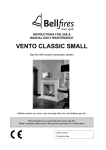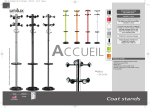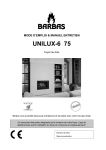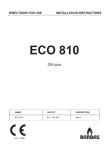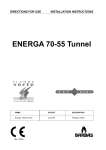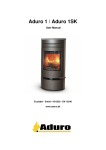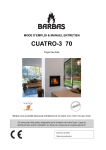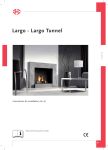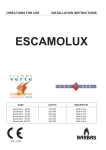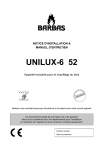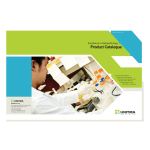Download User manual
Transcript
INSTRUCTIONS FOR USE & MAINTENANCE MANUAL UNILUX-6 40 Wood-burning appliance Barbas wishes you many cosy evenings with your new appliance This document is an essential part of your appliance. Read it carefully before use of the appliance and keep it in a safe place! Version number: 01 - 340650 Serial number: Date: 20-05-2015 Production date: UNILUX-6 40 Instructions for use 3 UNILUX-6 40 4 Instructions for use UNILUX-6 40 CONTENTS Page 1. INTRODUCTION ........................................................................................ 7 2. SAFETY ...................................................................................................... 7 3. OPERATION ............................................................................................... 9 4. USING THE APPLIANCE FOR THE FIRST TIME ...................................... 10 5. USE ............................................................................................................. 13 6. FUEL ........................................................................................................... 20 7. MAINTENANCE .......................................................................................... 22 8. FREQUENTLY ASKED QUESTIONS ......................................................... 24 9. TECHNICAL DATA ...................................................................................... 28 10. WARRANTY TERMS .................................................................................. 29 Instructions for use 5 UNILUX-6 40 6 Instructions for use UNILUX-6 40 1 NTRODUCTION Congratulations on your purchase of this modern Barbas appliance. This quality product will provide you with many years of enjoyment due to the flame effect and warmth that it provides. Study this manual carefully before using the fireplace. We recommend you keep this manual in a safe place for reference purposes. The images in this manual are made of a different variant of this appliance. The depicted appliance may differ from your device, but the actions and instructions shown are fully valid for the unit described here. 2 SAFETY Do not place flammable objects within 100 cm of the appliance. Pay special attention to furnishings and ornaments around the appliance. When you use your appliance, the exterior will become hot. Always wear the glove or use the accessories supplied when filling etc. Protect yourself and others (especially children!) from burns. Do not leave children unattended when the appliance is burning. Watch your clothing. Synthetic clothing in particular can easily catch fire and burn intensely. Do not approach the appliance with flammable materials or liquids. Any work with solvents, adhesives etc. in the space heated by the appliance can be very dangerous. It is not allowed to connect the appliance to a flue which is already connected to another appliance. Make sure you know what state your chimney is in. Cracks in the chimney may not only lead to damp, staining of walls and leaking of smoke, they can also impair the carrying off of smoke. Make sure you get proper advice from your dealer or other specialist company. Avoid chimney fires! Have your chimney swept at least once per year - more often if you use your appliance a lot. Prevent excessive deposits of soot inside the chimney by not burning freshly-cut wood. Instead, burn clean, dry chopped wood. Instructions for use 7 UNILUX-6 40 Ensure that the room in which the appliance is situated has adequate ventilation. It is essential that the appliance, the flue and combustion air supply are cleaned and inspected annually by a Barbas dealer/specialist. The safe operation of the appliance will thus remain guaranteed. The appliance must never be used with the door open or the door glass removed. Wood and wood briquettes may be stoked in the appliance. Coals can’t be burned in the appliance. Avoid over-loading (white burning glow), caused, for example, by lengthy burning with a fully open primary air vent (combustion air supply slider all the way to “ + ”), or by burning too much wood in one go. The appliance can then become over-heated. Never use the appliance to burn rubbish. Do not use your appliance as a barbecue. This can cause (flammable) fat deposits to be left in the chimney and hastens the chimney becoming clogged. Ensure at all times that children and other people who are not aware of the operation of a wood-burning appliance are only in the vicinity of the appliance exclusively under supervision. Use a fireguard to protect the people and children mentioned above against possible burns. The appliance is suitable and approved for intermittent use. The appliance can be taken in operation if national and local regulations are satisfied. The required constructive adaptations should be satisfied as well. 8 Instructions for use UNILUX-6 40 3 OPERATION 1 2 3 4 5 6 7 8 Handle Ceramic heat-proof glass Outlet opening (2x grate) (chimney breast) ventilation air chimney breast Grate Ashtray Inlet opening (2x grate)(chimney breast) ventilation air chimney breast Combustion air-supply slider (Combined operation for the primary, secondary and tertiary combustion air-supply) Inlet opening combustion air (if there’s no direct outside air supply) Instructions for use 9 UNILUX-6 40 4 USING THE APPLIANCE FOR THE FIRST TIME 4.1 GENERAL Allow your home to dry properly, after you have had your chimney breast modified or newly built. Walls which have not been allowed to dry properly are a magnet for dust such as any smoke particles created when stoking up the appliance or suddenly opening the door. Even scorched dust can easily be retained by damp walls. Think also of dust on the outside of the appliance or on hot radiators, lamps etc. Check that all packaging, stickers etc. and/or all dust and waste has been cleaned up after the installation work (to avoid it getting scorched/causing a bad smell). The appliance is coated with a lacquer layer resistant to high temperature. During the first hours of operation, the burning in of the lacquer may result in an unpleasant smell. This is harmless, however. To speed up the process, the appliance should be allowed to run for a few hours at the correct heat level, with adequate ventilation for the room in question. After using your appliance for the first few times, you may be aware of a light deposit on the inside off the glass. This is caused by the paint curing. Once your appliance has cooled down, this deposit can be removed with glass cleaner or ceramic hob cleaner. At the start of the heating season, check that the flue/chimney is not blocked, for instance by birds’ nests etc. 4.2 INCLUDED Documentation • • Instructions for use Installation instructions Attributes • • Glove (Heat resistant up to max. 95°C) Operating hook / Poker N.B. If any part is missing, please contact your dealer. 10 Instructions for use UNILUX-6 40 4.3 INSPECTION OF THE APPLIANCE BEFORE FIRST USE Check all available functions before using the appliance for the first time. • Check the opening and closing operation of the door. Turn the handle all the way down: Door is locked. Handle forwards: The door releases from its lock and can be opened forwards. For this, use the operating hook supplied. Instructions for use 11 UNILUX-6 40 • Check whether the 2 baffle plates are located correctly in the supports. • Check the operation of the slider for the regulation of the combustion air intake (middle below the window). • Check whether the ashtray is completely empty. • Report any defects immediately to your dealer. • Remove enclosed documents and components from the appliance. • Check that all grates in the fireplace are open. 12 Instructions for use UNILUX-6 40 5 USE 5.1 VENTILATION If wood is to burn, it needs air. For each kilo of wood that you put on the appliance (door closed), 10 - 15 m3 of extra air is needed. That means about 35 m3 per hour! Depending on how the appliance has been installed, the combustion air will either be drawn directly from outside or from the living room itself. If the air is drawn in from the room, it must be ventilated by an opening in the external wall. If the combustion air is led outside through a pipe, we recommend that a sealing valve is fitted in this pipe. This prevents condensation forming in the appliance when it is not in use. Ensure that the flap is always open before using the appliance. 5.2 GETTING THE APPLIANCE GOING When you start the appliance, the chimney is still cold and there is little draught. Before the fire is lit, turn the operating handle completely to the right (maximum air supply). Open any chimney valve and the valve in the external combustion air pipe. Place 4 wood blocks in the combustion chamber and place several fire lighting sticks on them diagonally. Place 2 fire lighting blocks between the fire lighting strips. Ensure that fire lighting strips are placed above the fire lighting blocks. Refer to the illustrations below. Light the fire lighting blocks and close the door as soon as they are well lit. After approximately 20 minutes the wood blocks will be completely lit. Leave the door closed as long as flames are visible. The appliance can be loaded again as soon as all of the flames have disappeared. Attention: If the door is opened during the lighting process, while all of the wood has not yet been burned, smoke can escape. Only open the door when you need to load more wood. Instructions for use 13 UNILUX-6 40 5.3 INSTRUCTIONS WHILE STOKING Using the air supply slider you can adjust the air supply for further combustion. Make sure the appliance burns quietly. Note: Once you have got the appliance going, leave the air supply slider in the centre position for optimal combustion. Your appliance will then be much cleaner and more efficient (more heat, less topping up). 14 Instructions for use UNILUX-6 40 Control range of primary air supply (by grate) Control range of secondary and tertiary air supply Combustion air supply slider Centre position We recommend that you maintain a substantial layer of ash (2 - 3 cm). This not only forms a protective layer for the base of the appliance but also significantly reduces consumption of fuel and allows new wood to catch light easier. When loading the appliance with fuel, two blocks measuring ca. 15 cm long and 25 cm perimeter is sufficient. Only load again when the last flames have disappeared. This is after approximately 45 minutes. Do not leave the door open longer than necessary. ê Weather conditions In order to reduce pollution and any other inconvenience, we advise not firing up the appliance when there is no wind, or in foggy/misty conditions. Smoke development Your appliance has been designed to be used with the load/observation door closed. Should you use it with the door open, under certain circumstances (presence of mechanical ventilation, draught, differences in barometric pressure) smoke may enter the room in which the appliance is situated. Use of the appliance Your appliance is suitable for periodic use. The appliance may only be positioned in a place where the location, construction and activity in the room can accommodate it without danger. Ventilation When using the appliance, ensure a good supply of fresh air, particularly if the combustion air is drawn from the room itself. Turn on the flue gas fan if the flue is fitted with one. Spare parts Any replacement parts must be new, original parts. Use of non-original/reconditioned parts will invalidate your warranty. Instructions for use 15 UNILUX-6 40 Modification Do not make modifications to your appliance. Any alteration to your appliance, of whatever nature, will also invalidate your warranty. Only open the door for filling and lighting the appliance and for removing the ash. Keep the door shut at all other times. Continuous stoking with the primary air supply open (combustion air supply slider is right over to the “ + ” position) (air through the grate) causes a fiercely white-hot fire that can damage the grate and other parts of the appliance. 5.4 HEATING ECONOMICALLY The most environmentally-friendly and economic way of heating with wood is to have your fire hot but calm. The ash should appear to glow a soft red-orange and should not glow like a blacksmith’s fire. Fires like that burn quickly and intensely, leaving little time for complete combustion. Your appliance is at its most economical when: • Using dry and clean wood (as described further in Chapter 6). • Always ensure even combustion. Stoke with the primary air regulator closed. To do this, place the combustion air supply slider in the centre position. • The bed of the fire should be homogeneous, and the fire must have easy access to air. Position the blocks of wood (loosely and evenly) horizontally on the bed of ash, so that they are separate and several centimetres away from the walls. 5.5 CLEANING THE WINDOW After several burning hours, a light deposit may form on the inner side of the window. Once the appliance has cooled down, this deposit can be removed using glass cleaner or ceramic hob cleaner. 16 Instructions for use UNILUX-6 40 5.6 INCREASE THE FLUE DRAUGHT Attention: Not possible if the appliance is equipped with a 45 degrees chimney connection. If there is too much flow resistance in the chimney, causing insufficent flow of of the flue gasses, one can increase the chimney draught. To do this, remove the upper baffle from the appliance and detach the back part of the baffle by moving this part back and forth until it breaks. (see figures hereunder) Subsequently, replace the baffle in the appliance. To reduce the chance of accidental escape of smoke, it is strongly adviced to follow the firing instruction as stated in 5.2. Instructions for use 17 UNILUX-6 40 5.7 GENERAL HEATING TIPS • Burn dry wood only. Damp wood not only burns poorly, it causes more pollution in the appliance (window), the chimney, your room (when opening the door of the appliance, for instance) and the environment. Wood can only be classified as dry if it has been stored under a Dutch barn for at least two years (not covered with plastic). Never use painted or impregnated wood. The gases emitted when burning painted or impregnated wood are aggressive and will affect the appliance, the environment and your health. • Ensure that your appliance burns well. The smoke generated should be translucent or white and the windows of the appliance will remain clean. We recommend that you do not ‘pinch off’ your appliance (by closing all air openings). Doing so will hinder combustion which, apart from polluting the atmosphere, will lead to deposits of soot and tar in your chimney (which, unchecked, will increase the risk of chimney fire). • Keep the door shut when the appliance is burning. Doing so improves the performance of your appliance 8 - 10 times, benefiting the environment and the heat in your home (less topping up). You will also prevent appliance damage from any particles the appliance ‘spits’ out (this is a particular problem with softwood from conifers). If your floor contains flammable material, an extra floor plate is required. • Avoid lighting an appliance in misty or still conditions. If the wind is still, there is hardly any draught in the cold chimney. As smoke is heavier than air, there is a chance that smoke will enter the room. If there is mist in the air, smoke coming out of your chimney will cool quickly and fall, causing problems in your area. • Do not extinguish your appliance with water - let it burn out. The part of the inner lining that is in direct contact with the appliance is clad with fire-resistant material. Sudden changes in temperature may lead to it deforming or cracks appearing. • Chimney fire. If, despite all the precautions, a fire should occur in the chimney (you generally notice that because of a roaring sound in the chimney), do the following: • Immediately shut the chimney flap (if fitted). • Immediately shut the air supply to the appliance. • Call the fire brigade (( 112). • Quickly quench the fire in the appliance with sand or soda in order to prevent smoke in your house. • Never use water to put out the fire. • Ventilate. • If there has been a fire in the chimney, have it swept and inspected for damage and leakage. 18 Instructions for use UNILUX-6 40 5.8 OUTPUT In practice, combustion is all about loss. This entails: • Loss through excess heat leaving the chimney, rather than going into the room. • Loss through insufficient combustion, such as CO (carbon monoxide) and soot particles. • Loss through excessive unburnt fuel in the ash. The rate at which fuel can burn completely is called the output. A well-stoked appliance achieves output of 75% and thus falls into the category of high-output / low emissions appliances. This means that you benefit directly by using less wood to achieve the same level of heat. The environment benefits as well: a well-stoked, high-output appliance means less pollution and fewer odours. Adverse effects on the output are: • Burning the appliance with the door open. A warm chimney works in the same way as an extractor. When the door is open, the chimney draws in much more air than is necessary for combustion. This relatively cool air cools down the appliance. • Excessive chimney draught. The combustion air does not reach the fuel, but leaves the appliance via the chimney. The appliance cools and the combustion quality decreases. • Using too much wood. This is a problem if your appliance is too small. In that case, it becomes overloaded and burns more wood than heat emitted. In this case too the fuel cannot burn completely. More to the point, there is not enough air to mix with the flames. This has an extra impact on the environment. • Admitting too much air under the fuel (combustion air supply slider is than fully over to the “ + ” position). Combustion is raised to high intensity (like a blacksmith’s fire). Combustion really needs time. If combustion is too intense, there is insufficient time for the fire to radiate all the heat. The chimney will become excessively hot and the same will be true of the escaping smoke. This heat is thus lost. Instructions for use 19 UNILUX-6 40 6 FUEL Use only the suitable fuels listed hereunder. Always avoid the use of fuels not suited for this appliance. 6.1 WOOD Suitable fuels are: • All sorts of clean wood (forested). The wood must have been dried for at least two years. Well-dried wood has a humidity percentage between 10 and 20%. Recommended dimensions: • length : c. 15 cm • outline : c. 25 cm ê • Wood briquettes without binder (see wood dimensions). • Hard woods burn slowly and easily form charcoal; for example hornbeam, oak, ash, beech, elm and birch. Softwood burns with more flame, but forms less charcoal and radiates less heat. Examples are spruce, pine, poplar and linden. Unsuitable fuels are: • Painted, bonded (chipboard, MDF etc.) or impregnated wood, plastic and other flammable waste. Stoking an appliance with this is completely forbidden. The combustion gases released by these materials are aggressive and will attack your appliance and the environment. • Paraffin-containing open appliance lighters are not suitable for a closed appliance. A closed appliance generates more heat than an open appliance, thus the paraffin will melt out of the blocks prematurely. • Damp wood burns poorly, is unsuitable and produces too much smoke (including in the room when you are topping up the wood), dirties the glass, leaves deposits in the chimney and delivers about half the heat output of dried wood. Do not burn coal, liquid fuels or burning gel in the appliance. The appliance is not designed for this. Use is dangerous and can lead to health damage and serious damage to the appliance. Each appliance is constructed for a certain maximum amount of fuel. Remember that the more fuel you put into your appliance, the hotter it will become and overheating may even occur. If this happens, there is a risk of fire. It may also damage your appliance and chimney. BARBAS will not assume liability for damage caused by overheating. Burning one layer of wood can lead to varying outputs. When used correctly, one load will burn in around 45 minutes. Putting in too much wood at once can lead to the appliance being overloaded and can cause excess smoke. 20 Instructions for use UNILUX-6 40 Per filling: (= for 45 minutes) Wood: 2 blocks each around 0.6 kg Briquettes: 2 blocks each around 0.5 kg Dimensions wood block: c. 15 cm long and 25 cm perimeter ê. The maximum burning load is based on a nominal capacity of 5 kW and a efficiency of 76%. 6.2 HEAT RADIATION The table below shows the temperatures which can theoretically be achieved by burning wood. Heat radiation Sort of fuel kWh/kg Dry wood (average) 4.3 Briquettes (average) 5.0 The heating value of wood (18.7 MJ/kg at 0% humidity) is not affected by the sort of wood. What does make a difference is the relative humidity of the wood (15.6 MJ/kg at 15% humidity). Instructions for use 21 UNILUX-6 40 7 MAINTENANCE • Emptying the ashtray : • Regularly check how much ash is in the ashtray. • Make sure the ashtray is never more than ¾ full. If the ashtray is more than ¾ full, it can obstruct the flow of air to the appliance. • Wait 24 hours after stoking before emptying the ashtray. • Cleaning the glass : • Regularly clean the glass on the inside of the appliance with glass spray or ceramic hob cleaner. Attention !! If the glass is not cleaned on time, this can result in becoming dull and difficult, if not impossible, to clean. • If the glass is broken or cracked, it must be immediately replaced before operating the appliance again. Broken ceramic heat-resistant glass may not be thrown away in a glass container, but must be included in normal household waste. • Cleaning the appliance : • Wait for the appliance to cool down sufficiently before cleaning. Never use scouring powder, aggressive cleaners or fire polish on the appliance. Use only a dry lint free cloth. • Regularly remove any dust deposits from behind the door by means of a vacuum cleaner. • Door seals : Check annually before heating is resumed. Replace as necessary • Sweep and inspect chimney : Annually before heating is resumed • Appliance interior : Check annually * Replace panels as necessary • Grate : Check annually for cracks / breakage • Sliders/dampers : Check function annually • Paint : Check annually, if necessary touch up with BARBAS heat-resistant paint (do not paint when the appliance is in use!) 22 Instructions for use UNILUX-6 40 • Parts : Individual parts for replacement/accessories are available from your BARBAS dealer Use only original parts • Modifications : Introduced modifications to the appliance are not permitted • House : Ensure that as little dust, and as few particles of cigarette smoke, candles and oil lamps as possible pollute the air in the room in which the appliance is used. Heating of these particles by the convection system of the appliance could lead to discoloration of the walls and ceiling. It is therefore very important to ensure that the room in which the appliance is located is sufficiently ventilated. Instructions for use 23 UNILUX-6 40 8 FREQUENTLY ASKED QUESTIONS How often should I have my chimney swept? At least once a year. If you use your appliance more than three times a week on average, have your chimney swept more often. Have the chimney swept by a recognised company. Your fire insurance policy may make this a condition and ask for proof. Does a closed appliance have better output than an open appliance? Yes, a closed appliance has between 8 and 10 times the efficiency of an open appliance. (See also Chapter 5.7.) What is the difference between net capacity, gross capacity and efficiency? Net capacity (= Nominal output) represents the net amount of heat that the appliance generates. The total heat content of the fuel is the so called gross capacity. Efficiency is the percentage of fuel converted into useful heat. It is the ratio of net capacity and gross capacity. How can I keep the glass clean? By making a point of using dry, clean wood in the appliance. Wood that is too damp immediately gives off lots of ash. Make sure the seals are in good working order. Any air seeping out around the glass part of the door will cool the air, resulting in the appliance not burning cleanly. How much wood will I use? That depends entirely on how you heat your room, what sort of appliance you have and the size of the room you are heating. As a general rule, an appliance used in accordance with our guidelines (no air under the fuel, topped up once an hour) each kg wood produces an output of about 3 kW. In an averagely-insulated house, the general rule is that in a room of 80 m3, you need an appliance with an output of around 7 kW. For each subsequent 10 m3, add on 0.6 kW. In a relatively well-insulated house, the general rule is that in a room of 80 m3, an appliance of 5.5 kW is adequate, and for each subsequent 10 m3, you need to add a further 0.4 kW. 24 Instructions for use UNILUX-6 40 Can a wood-burning appliance/fireplace insert be connected to a central heating installation? The Barbas range does not have any appliances that can be connected to central heating installations. We do not advise attempting it!! How do I know if I’m heating correctly? Follow the instructions in this manual. The flames should play softly across the wood and the wood should burn evenly. Once the fuel has been burning for a short time, the smoke from the chimney should be almost translucent. What is wrong with a smoking chimney? A seriously smoking chimney means that combustion is less than optimum. There may be a number of reasons for this. If the appliance has only just caught on, or has recently been topped up, some smoke is normal. By opening the door for a short period, the wood will catch fire quicker and the smoky period will be shorter. If you leave the appliance door open, and especially if you burn damp wood, the result will be a lot of smoke. In both cases, the combustion temperature is too low. This leaves numerous dangerous compounds intact, which means more deposits in your chimney and more waste into the environment. What should I do if the wood does not catch fire? This probably means that the wood is damp. Remove the wood and replace it with dry wood. If necessary, make a fire with wood briquettes. They are always dry (they have a moisture content of <10%). The wood burns up too quickly. What should I do? Ensure that air cannot get in underneath the fuel. Move the combustion air supply slider towards the “ - ” position. (The primary air supply is now closed.) Under these conditions, the layer of ash should no longer burn bright orange/white but red. If there is a draught (due to strong wind), air intended as secondary air for above the fuel may enter through the openings above the door and flow straight down beneath the wood. Also slide the combustion air supply slider tighter shut. There may be too much of a draught in your chimney, particularly if it is very high (in excess of 8 m). Ask your supplier to fit a check valve or damper. This may not be possible in all cases. Instructions for use 25 UNILUX-6 40 Can I leave my appliance unattended? Only do this when the appliance is burning quietly, with just a little wood, with a closed door and with the combustion air supply slider in the centre position between “ + ” and “ - ”. In this position, the primary air supply is closed and the secondary/tertiary air supply is open. • Primary air is supplied through the grate in the bottomplate (appliance base). • Secondary air is supplied through the small holes in the rear panel of the combustion chamber. • Tertiary air is supplied through the opening behind the glass, on the upper side of the combustion chamber. Do not leave children unattended while the appliance is burning. Do I have to take any extra measures if the room I am heating has an extractor fan (mechanical ventilation)? If the combustion air comes from the living-room: A flue gas fan is required for permanent extraction of the area in which the appliance is placed. The type of flue gas fan depends on the capacity of the extractor system. Always consult your installation engineer about this. If the combustion air comes directly from outside via a direct connection: If there is constant extraction of the room in which the appliance is located, no additional provisions are necessary. What is creosote? Creosote is a tar-like deposit which is left in the chimney. It is formed in poor combustion conditions when burning wood (damp wood, pinching off the air supply to the appliance or burning impregnated or painted wood for example). Creosote ignites at approx. 500°C. This temperature can easily be reached if the appliance is raging. This means that deposits of creosote in your chimney could cause a chimney fire. What happens when wood is burnt? The combustion process. The combustion of wood involves the following steps: Drying The first step is that the fuel (wood) dries out. Even at low temperatures (~ 100°C), any moisture still in the wood will evaporate. This drying procedure implies a significant loss of energy if wood which is ‘too’ damp is burnt. The right degree of moisture is achieved after 1.5 - 2 years of drying. The moisture content is then 15 - 17%. 26 Instructions for use UNILUX-6 40 Decomposition At moderate - high temperatures (150°C - 350°C), the decomposition process can be discerned. This is when the chemical structure of the fuel breaks down. This process involves the creation of volatile compounds such as carbon monoxide (CO), water vapour (H2O) and methane (CH4). In addition, substances which are volatile at decomposition temperature but condense at lower temperatures are often released. These are the tar-like components (this by-product is also known as creosote, which is deposited in the chimney and cold parts of the appliance in poor burning conditions). Combustion of the products of decomposition The volatile compounds burn in the gas phase if O2 (air) is added. The ignition temperature of these volatile compounds is approx. 550°C. Combustion of solid hydrocarbons The solid component that remains consists of pure hydrocarbons, which will burn at approx. 800°C if O2 (air) is added. Instructions for use 27 UNILUX-6 40 9 TECHNICAL DATA Combustion: Measured in compliance with EN 13229 : 2001 and EN 13229 - A2 : 2004 Fuel Nominal output Efficiency Wood 5 kW 76% Emissions (dry, at 13% O2, 273 K, 1013 hPa): Carbon monoxide (CO) 0.09%; 1043 mg/m3 Dust 40 mg/Nm3 Total hydrocarbons (CxHy) 83 mg/m3 Nitrogen oxides (NOx) 128 mg/m3 Flue gas mass flow Flue temperature Chimney draught Flue gas connection Weight 5.8 g/s 293°C 0.12 mbar Ø122 mm (Ø128 mm ext.) 69 kg Inside: Interior side panels Interior bottom Inner lining Bottom baffle plate Top baffle plate Heat-resistant panels 1400 kg/m3, 1300°C Steel (heat-resistant and rust-proof) Steel (heat-resistant and rust-proof) Heat-resistant panel 2000 kg/m3, 1300°C Stainless steel Outside: Construction Doors Sheet-steel casing. Flat door opening to left. Shutter with fixed handle. Operation: • Handle for opening the door. • Combustion air supply slider Single combined slide for controlling the primary, secondary and tertiary air supply. Ash collection: Ashtray with grate. Combustion air supply: At least 150 cm2 opening in the room where the fire is located or a outside air supply opening of Ø80 mm in wall/floor. 28 Instructions for use UNILUX-6 40 10 WARRANTY TERMS Interfocos Warranty terms Interfocos B.V. guarantees the quality of the supplied Barbas appliance and the quality of the materials used. All Barbas appliances are developed and manufactured according to the highest possible quality standards. If, despite all this, something should prove amiss with the Barbas appliance you have purchased, Interfocos B.V. offers the following manufacturer’s warranty. Article 1: Warranty 1.1. If Interfocos B.V. determines that the Barbas appliance you have purchased is defective as a result of a flaw in the construction or material, Interfocos B.V. guarantees to repair or replace the appliance free of charge, without charging any costs for labour or spare parts. 1.2. Repair or replacement of the Barbas appliance will be undertaken by Interfocos B.V. or by a Barbas dealer as designated by Interfocos B.V. 1.3. This warranty is supplementary to the existing legal national warranty of Barbas dealers and Interfocos B.V. in the country of purchase and is not intended to restrict your rights and claims based on the applicable legal provisions. Article 2: Warranty conditions 2.1. Should you wish to claim under the warranty, please contact your Barbas dealer. 2.2. Complaints should be reported as quickly as possible after they have manifested themselves. 2.3. Complaints will only be accepted if they are reported to the Barbas dealer, together with the serial number of the Barbas appliance which is stated on the front of the instructions for use. 2.4. In addition, the original receipt (invoice, receipt, cash receipt) showing the date of purchase must also be submitted. 2.5. Repairs and replacements during the warranty period do not give any entitlement to an extension of the warranty period. After a repair or replacement of warranty parts, the warranty period shall be deemed to have started on the date of purchasing the Barbas appliance. 2.6. If a certain part is eligible for the warranty and the original part is no longer available, Interfocos B.V. shall ensure that an alternative part of at least the same quality shall be provided. Article 3: Warranty exclusions 3.1. The warranty on the Barbas appliance ceases to be in effect if: a. it is not installed according to the supplied installation instructions, and to national and/or local regulations; b. it has been installed, connected or repaired by a non-Barbas dealer; Instructions for use 29 UNILUX-6 40 c. d. e. 3.2. it has not be used or maintained according to the instructions for use; it has been changed, neglected or roughly treated; it has been damaged as a result of external causes (outside the appliance itself), for example, lightning strike, water damage or fire; In addition, the warranty lapses if the original purchase receipt shows any change, deletion, removal or if it is illegible. Article 4: Warranty area 4.1. The warranty is only valid in those countries where Barbas appliances are sold through an official dealer network. Article 5: Warranty period 5.1. This warranty will only be granted during the warranty period. 5.2. The body of the Barbas appliance is guaranteed for a period of 10 years against construction and/or material faults, starting from the moment of purchase. 5.3. For other parts of the Barbas appliance, a similar warranty applies from the moment of purchase for a period of one year. 5.4. For user parts such as glass, glass (cord), thermocouple and the interior of the combustion chamber, a similar guarantee is given until after the first burning. Article 6: Liability 6.1. A claim granted by Interfocos B.V. under this warranty does not automatically imply that Interfocos B.V. also accepts liability for any possible damage. The liability of Interfocos B.V. never extends further than that stated in these warranty conditions. Any liability of Interfocos B.V. for consequential damage is expressly excluded. 6.2. That stated in this provision is not valid if and to the extent that is derives from a mandatory provision. 6.3. All agreements entered into by Interfocos B.V. are, unless specifically stated otherwise in writing and to the extent that they are permitted based on applicable law, subject to the Conditions of the Dutch Metal and Engineering Association (METAALUNIEVOORWAARDEN), as filed with the registrar of the Court of Rotterdam on 1 January 2014. Interfocos B.V. Hallenstraat 17 5531 AB Bladel The Netherlands Tel: +31-497339200 Email: [email protected] Carefully retain the instructions for use; they show the serial number of the appliance. You will need this if you wish to claim under the warranty. 30 Instructions for use Your Barbas dealer 01 - 200515 - 340650
































